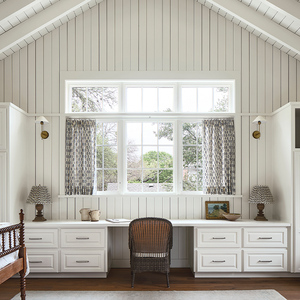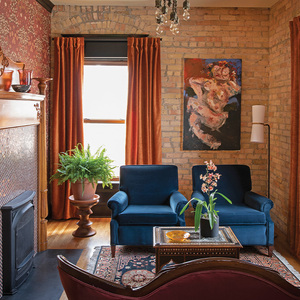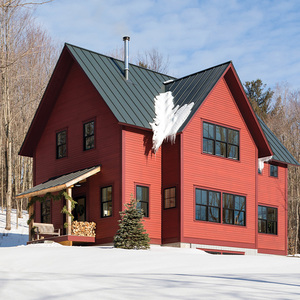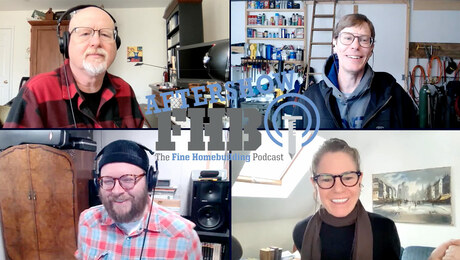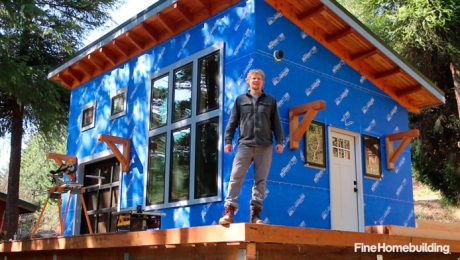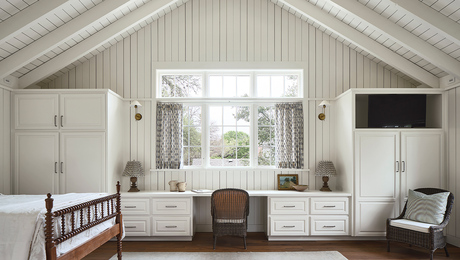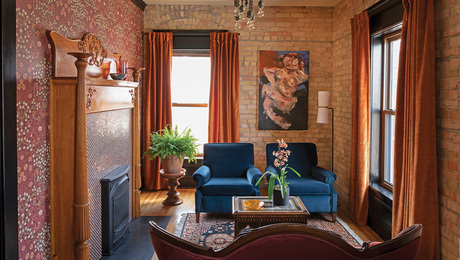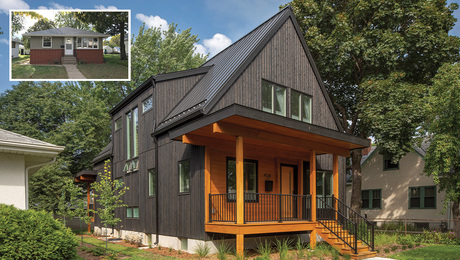Smaller House, Better Investment
Whether you’re planning for retirement or looking to live life to the fullest right now, buying a small house might be the best way to achieve both goals
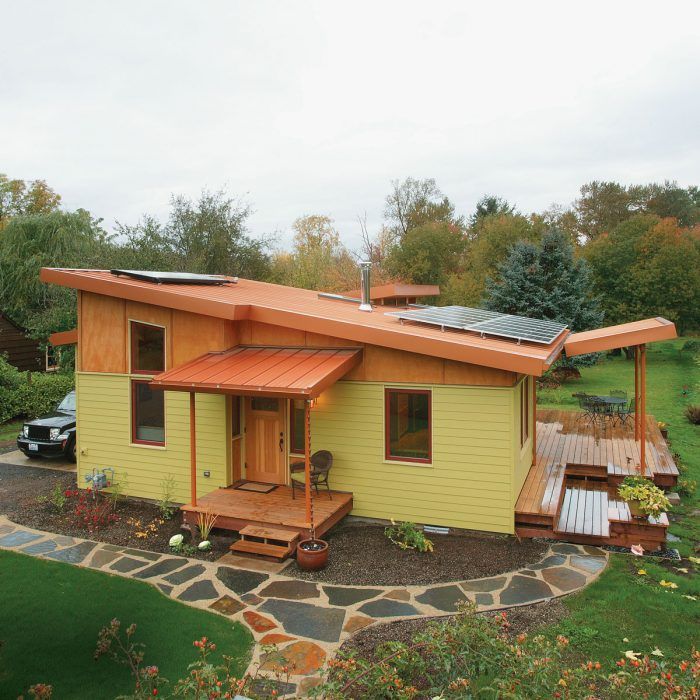
During the housing boom of the early 2000s, a growing number of real-estate professionals began to encourage their clients to buy big now and trade down later as a means of achieving financial security during their golden years. The hype—you can impress your friends with a large house and still have loads of cash to spend on dream vacations when you retire—might be mistaken for one of those get-rich-quick gimmicks advertised on late-night television. At first blush, this strategy of real-estate ownership as retirement planning might seem to have some merit. As you will see, however, the attractiveness of the plan depends largely on the assumptions you’re willing to make about future returns and long-term expenses, and on whether you’re a real-estate agent or a homeowner.
Home buying as retirement planning
The math works like this. Let’s say we know twin sisters, Betty and Carol, each with similar jobs and comparable incomes. Both are in the market for a new home. Spurred on by her real-estate agent, Betty buys a cavernous estate home valued at $850,000 and puts down $50,000 at closing. A 35-year-old, she plans to pay off the $800,000 debt by working hard and pinching pennies over the term of her 30-year mortgage. It’s more house than Betty needs, but she reckons it’s her ticket to retirement on easy street. Carol is more cautious. In the same town, she acquires an average-size home valued at $350,000, also putting down $50,000 and financing the balance with a $300,000 mortgage.
“Instead of living large, she just lives in a large home.”
The sisters’ choices could hardly be more different. It’s immediately apparent that Carol’s debt is less than half of Betty’s. Every month, Betty struggles under a huge debt service while Carol’s personal finances are less burdensome. Assuming a 30-year fixed-rate mortgage and an interest rate of 6.5%, Betty must fork over a monthly payment of more than $5000. By contrast, Carol’s monthly payment comes in under $2000. That’s a shocking difference.
Betty’s payments leave her with a scary cash-flow problem. She’s house rich, cash poor. By the time she’s done paying the mortgage, not much money is available for personal spending. There’ll be no fancy vacations or digital home theaters in her future. Instead of living large, she just lives in a large home.
More important, the big mortgage leaves Betty with no money to invest in a conventional retirement account because every available dollar is set aside for her real-estate obligations. This situation doesn’t bother her, however, because she’s planning on selling the house when she retires and living off the proceeds. By contrast, Carol uses her much larger discretionary income to contribute to her 401(k) at work and maxes out her employer’s matching contribution.
Cashing in the house
As the decades fly by, both houses appreciate subject to inevitable cycles of boom and bust. For purposes of our simplified comparison, we’ll assume the sisters’ homes appreciate at equivalent rates. We’ll also assume that real-estate appreciation outpaces inflation. Say the annual inflation rate stays at roughly 2.5%, and real estate appreciates at 5% on average. Forget about those meteoric growth rates of property values in recent years; they’re history.
By the time the sisters reach age 65, they have paid off their mortgages and are ready to retire. Carol’s house has risen in value to $640,000, an increase of $290,000. On the other side of town, Betty’s upscale house has appreciated to $1,550,000, a gain of $700,000. Betty sells her house and “trades down” to a modest residence for her retirement. In fact, she buys the house right next door to her sister Carol for $640,000. After paying cash, Betty still has $910,000
left over.
At this point, the trade-down strategy sounds like a winner. Betty retires to the same-size house as Carol and has almost an extra million dollars in her pocket. Maybe you should stop reading this article right now and call your realestate agent.
Unfortunately, that could be a costly mistake. As the saying goes, if something sounds too good to be true, it probably is. Here, it’s not a case of the numbers being wrong but a matter of dubious assumptions. Stop for a moment and think of the leaps in reasoning that led to Betty’s cash cow.
“The true beneficiaries of this ‘investment’ strategy might be the real-estate agents.”
Where did all the money go?
For starters, our adventure subjects Betty to a real-estate sale. Let’s say that real-estate agents’ commissions remain around 5% of the sales price. In Betty’s case, that’s $77,500 out of her pocket, reducing her retirement funds to $832,500.
Then there’s the IRS. While current income-tax laws favor capital gains relative to other sources of earnings, there’s no telling if that preference will continue indefinitely. Let’s say Betty’s capital gain ($700,000) is taxed at the current rate of 15% and is eligible for the current exclusionary amount of $250,000. That’s another $67,500 to the taxman. Chop the exclusionary amount in half and bump up the capital-gains rate to match ordinary income, and the tax hit could be larger, possibly as high as $195,000.
Predicting future tax laws is fraught with uncertainty, but you get the point: Income taxes are a significant wild card. Let’s give Betty the benefit of the doubt, however, and assume that today’s tax laws are still in effect. This reduces her available retirement funds to about $765,000. Still not bad, but she’s down to about half of the proceeds from the sale of her house—and we’re not done yet.
Small-home owner rides the stock market
A proper comparison must consider the investments Carol took advantage of while Betty’s money was tied up. This is what economists call “opportunity cost.” Our model assumes Betty’s hefty mortgage left her unable to invest in other retirement plans, while Carol could dump funds into her 401(k) with every paycheck. Let’s say she contributed the $15,000 annually that’s currently allowed by law. That $1250 each month is really quite reasonable when you consider that Carol and Betty had similar incomes and Betty was able to shoulder an additional $3000 in mortgage payments every month. Carol still had money left over for dinners out and for vacations.
If Carol favored a risk-averse portfolio, she might choose conservative investments with safe but low-yield returns, like highly rated bonds. By tucking away $1250 per month at 4.5%, subject to 30 years of compounding, she would see her contributions grow to $937,262 by the time of her retirement. Maxing out her employer’s contribution each year would add to this sum. This figure more than offsets what’s left of Betty’s surplus from her “trade-down” strategy. So much for the purported benefits of that plan.
If Carol’s portfolio were a bit more ambitious, she might jump on a mutual fund indexed to leading equities. Riding out the stock market’s highs and lows over 30 years, the same monthly contribution ($1250) at 7.5% would generate a whopping $1,613,304 by retirement (plus any employer contributions). These numbers leave Carol ahead of Betty by nearly $1 million at retirement.
Okay, you say, but what about taxes? We haven’t considered the tax consequences of Carol’s nest egg, but here, too, she enjoys an advantage. When the time comes to withdraw money from her 401(k) at retirement, Carol likely will find herself in a lower tax bracket than during her productive wage-earning years. One of the secrets to her success is that she was able to invest pretax dollars.
Carol also was able to invest more after-tax dollars that her sister just didn’t have because Betty faced additional costs with her larger home. Besides a bigger mortgage, you can be sure Betty was stuck with a higher assessment than Carol. Applicable rates vary widely across the country, but Betty’s property-tax bill easily could have been more than twice what Carol paid. Next, think about the costs of routine maintenance and repairs, which were bound to be higher in Betty’s mansion than in Carol’s modest home. The larger the house, the costlier the repairs; likewise for homeowner’s insurance and basic utilities. Let’s figure Betty’s higher insurance, maintenance, and utility expenses set her back $5000 more per year compared to Carol, and that she paid $6000 more than Carol in annual property taxes.
Over 30 years, these expenses add up to a $330,000 reduction in Betty’s net worth relative to her sister’s. This is money that Carol was able to invest. For instance, she might have contributed $4000 a year to a Roth IRA, where it grew tax free into $150,000 (4.5% return) or $300,000 (7.5% return). Carol then could sock the remaining $7000 annual advantage over Betty into a college savings account to help her niece attend college and medical school. Betty can’t assist her daughter with tuition; her money was all tied up in making those huge mortgage payments.
In the final analysis, each of these calculations is plagued with uncertainty. Will residential real estate outperform financial markets? By how much will either of these investments outpace inflation? How politically safe are the current tax preferences for retirement savings versus home ownership?
In truth, nobody really knows the answers. But for Carol to come out worse off, she would have to lose money in the stock market year after year. That’s not very likely. Even if she tucked $15,000 into her mattress every year and hoarded the difference in taxes and maintenance costs in a cookie jar, she’d still have more money at retirement than Betty.
Clearly, Betty would have more legroom to kick up her feet at the end of a hard day. But that extra space can come with a steep price. When looking at the true costs associated with owning a large home to keep up with the Joneses, one can’t help but wonder if the true beneficiaries of this “investment” strategy are the real-estate agents who stand to profit from larger sales commissions.


